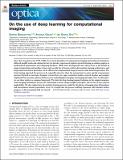On the use of deep learning for computational imaging
Author(s)
Barbastathis, George; Ozcan, Aydogan; Situ, Guohai
DownloadPublished version (3.208Mb)
Publisher Policy
Publisher Policy
Article is made available in accordance with the publisher's policy and may be subject to US copyright law. Please refer to the publisher's site for terms of use.
Terms of use
Metadata
Show full item recordAbstract
Since their inception in the 1930–1960s, the research disciplines of computational imaging and machine learning have followed parallel tracks and, during the last two decades, experienced explosive growth drawing on similar progress in mathematical optimization and computing hardware. While these developments have always been to the benefit of image interpretation and machine vision, only recently has it become evident that machine learning architectures, and deep neural networks in particular, can be effective for computational image formation, aside from interpretation. The deep learning approach has proven to be especially attractive when the measurement is noisy and the measurement operator ill posed or uncertain. Examples reviewed here are: super-resolution; lensless retrieval of phase and complex amplitude from intensity; photon-limited scenes, including ghost imaging; and imaging through scatter. In this paper, we cast these works in a common framework. We relate the deep-learning-inspired solutions to the original computational imaging formulation and use the relationship to derive design insights, principles, and caveats of more general applicability. We also explore how the machine learning process is aided by the physics of imaging when ill posedness and uncertainties become particularly severe. It is hoped that the present unifying exposition will stimulate further progress in this promising field of research. ©2019 Optical Society of America.
Date issued
2019-07Department
Massachusetts Institute of Technology. Department of Mechanical Engineering; Singapore-MIT Alliance in Research and Technology (SMART)Journal
Optica
Publisher
The Optical Society
Citation
Barbastathis, George et al., "On the use of deep learning for computational imaging." Optica 6, 8 (July 2019): p. 921-943 doi. 10.1364/OPTICA.6.000921 ©2019 Authors
Version: Final published version
ISSN
2334-2536